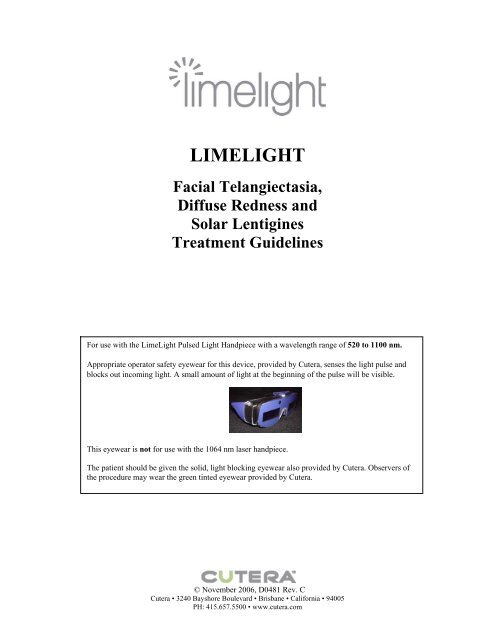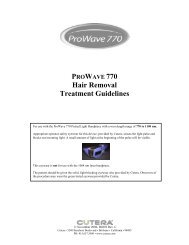Solar Lentigines Treatment Guidelines - Medsystems
Solar Lentigines Treatment Guidelines - Medsystems
Solar Lentigines Treatment Guidelines - Medsystems
Create successful ePaper yourself
Turn your PDF publications into a flip-book with our unique Google optimized e-Paper software.
LIMELIGHT<br />
Facial Telangiectasia,<br />
Diffuse Redness and<br />
<strong>Solar</strong> <strong>Lentigines</strong><br />
<strong>Treatment</strong> <strong>Guidelines</strong><br />
For use with the LimeLight Pulsed Light Handpiece with a wavelength range of 520 to 1100 nm.<br />
Appropriate operator safety eyewear for this device, provided by Cutera, senses the light pulse and<br />
blocks out incoming light. A small amount of light at the beginning of the pulse will be visible.<br />
This eyewear is not for use with the 1064 nm laser handpiece.<br />
The patient should be given the solid, light blocking eyewear also provided by Cutera. Observers of<br />
the procedure may wear the green tinted eyewear provided by Cutera.<br />
© November 2006, D0481 Rev. C<br />
Cutera • 3240 Bayshore Boulevard • Brisbane • California • 94005<br />
PH: 415.657.5500 • www.cutera.com
LimeLight <strong>Treatment</strong> <strong>Guidelines</strong><br />
The following guidelines are based on physician feedback from treatments with the LimeLight Pulsed Light<br />
Handpiece on patients with Fitzpatrick skin types I–IV. <strong>Treatment</strong> of patients with skin type V and VI using the<br />
LimeLight Pulsed Light Handpiece is not recommended. Additional treatment information is discussed in the<br />
Clinical Presentations CD included with the system.<br />
The LimeLight should only be operated by qualified practitioners who have received appropriate training and have<br />
thoroughly read the operator manual. Protective eyewear must be worn by all people in the treatment room.<br />
Consult the Operator Manual for additional information, including contraindications and possible adverse effects.<br />
PRE-OPERATIVE CONSIDERATIONS:<br />
• Conduct a patient consultation complete with medical history prior to treatment.<br />
• Patients should not be treated if they have had significant sun exposure, or artificial (light based or sprayon)<br />
tanning, in the 4 weeks prior to treatment.<br />
• Clean the skin, including removal of all make-up and other skin care products. Any creams or products left<br />
on the skin can interact with the light and increase the risk of unwanted side effects.<br />
• Shave any hair in the area to be treated.<br />
• Pre-operative photographs should be taken with consistent technique (patient positioning, camera settings,<br />
and room lighting) prior to the initial treatment for general reference. Printed pre-operative photos can also<br />
be used to compare and duplicate the same patient position when taking follow-up photos.<br />
• Pigmented lesions should be evaluated for potential skin cancer warning signs prior to treatment. If these<br />
are present, the lesion should not be treated unless diagnosed as benign.<br />
• These treatments can be tolerated without anesthesia. Topical anesthesia can be used if desired. It must be<br />
completely removed prior to treatment. CAUTION: Toxicity may result with overuse of topical anesthesia.<br />
Consult the manufacturer's labeling.<br />
• When treating near the mouth, rolled-up gauze can be placed between the lips and teeth to protect the teeth<br />
from discomfort.<br />
• Although this device has not been optimized for hair removal, patients should be advised that hair removal<br />
may occur as a result of these treatments.<br />
• Do not treat over areas with tattoos.<br />
• Extreme caution should be used when treating near the eye, taking care to avoid ocular damage from the<br />
light. Patient eye protection appropriate for the given treatment should be used. The light should always be<br />
pointed away from the eye and only applied to the skin outside of the orbital rim. Skin at the edge of the<br />
orbital rim can be treated by pulling it away from the eye while simultaneously holding the goggles in<br />
place, so treatment is kept outside of the orbital rim.<br />
© November 2006, D0481 Rev. C LimeLight <strong>Treatment</strong> <strong>Guidelines</strong><br />
Page 2 of 4
LIMELIGHT TREATMENT PARAMETERS:<br />
<strong>Treatment</strong> of a test area should be performed and observed for the desired response and signs of unwanted side effects.<br />
Settings for full treatment should be based on test area results. A waiting period of 20 to 30 minutes is recommended<br />
for most patients when treating lentigines. Darker skin types may require 24 to 48 hours to develop.<br />
SKIN<br />
TYPE<br />
CONDITION PROGRAM FLUENCE<br />
(Face)<br />
I-II Fine Telangiectasia and<br />
Diffuse Redness on<br />
patients with light skin<br />
I-III Telangiectasia, Diffuse<br />
Redness and <strong>Solar</strong><br />
<strong>Lentigines</strong><br />
IV and III<br />
with actinic<br />
bronzing*<br />
Telangiectasia, Diffuse<br />
Redness and <strong>Solar</strong><br />
<strong>Lentigines</strong><br />
A 12 – 18 J/cm 2<br />
B 12 – 26 J/cm 2<br />
C 12 -22 J/cm 2<br />
FLUENCE<br />
(Neck, Chest & Body)<br />
<strong>Treatment</strong> in these areas<br />
usually requires 2-4 J/cm 2<br />
less than on the face for<br />
similar conditions.<br />
This device is not intended<br />
for the treatment of leg<br />
veins.<br />
* Actinic bronzing is chronic “tan-like” pigmentation damage resulting from long-term sun exposure. This is<br />
different from recent sun exposure, which should not be treated.<br />
Specific parameters are provided as a guide only. Select parameters depending on color and density of lentigines,<br />
hair density, vascularity, and actinic bronzing. Observe light-tissue interaction and clinical endpoints to determine<br />
appropriate settings. Patients with skin type IV should be treated with caution. <strong>Treatment</strong> of patients with skin types<br />
V and VI is not recommended.<br />
• <strong>Treatment</strong> is not recommended for areas of recent sun exposure or tanning.<br />
• The LimeLight has three program modes (A, B, and C) which control the wavelength distribution, pulse<br />
duration, and epidermal cooling:<br />
o Program A is the most aggressive program [shortest wavelength distribution and shortest pulse<br />
durations] and is intended for patients with light skin and fine vascular targets if Program B does<br />
not give the desired response. This mode can also be used for low-contrast lentigines on patients<br />
with light skin.<br />
o Program B is the most commonly used program and is intended for patients with vascular and/or<br />
pigmented targets.<br />
o Program C is the least aggressive program [longest wavelength distribution and longest pulse<br />
durations] and is intended for patients with darker skin.<br />
• Sun Mode increases the treatment window temperature from the standard setting, 5° or 10° C, to 20° C.<br />
Recommended use of Sun Mode:<br />
o Telangiectasia or combination of telangiectasia and lentigines:<br />
� Sun Mode off (standard cooling)<br />
� Thin layer of gel<br />
o <strong>Lentigines</strong> only:<br />
� Sun Mode on<br />
� No gel<br />
� Allows reduced fluence for effective treatment<br />
• Prior to treating each patient, the program, the fluence, and the repetition rate settings must be determined.<br />
If in doubt about which Program to use, it is safest to use the longer wavelength program of the two choices<br />
(i.e. B over A and C over B).<br />
• The program should always be entered first, as each time the program is changed, the system will recall the<br />
fluence and repetition rate last used with that particular program.<br />
© November 2006, D0481 Rev. C LimeLight <strong>Treatment</strong> <strong>Guidelines</strong> Page 3 of 4
• The fluence setting should be selected to provide the desired treatment without effecting the pigmentation<br />
of background skin.<br />
• Use lower fluences for darker targets, both pigmented and vascular, or over bony areas.<br />
• The potential for overtreatment is greatest with skin type IV and patients with the pigmentary effects of<br />
long-term tanning (actinic bronzing). Begin with low settings for the initial test treatment.<br />
• Fluence settings should not be based on settings used with other pulsed light devices.<br />
RECOMMENDED TECHNIQUE:<br />
• When telangiectasia are present, with or without solar lentigines, apply a thin layer of clear (no color)<br />
ultrasound gel and use standard cooling (5° or 10° C).<br />
• When only solar lentigines are present, use Sun Mode and no gel. This allows use of reduced fluences.<br />
• Place the entire light-emitting window in contact with the area to be treated.<br />
• Activate the light pulse.<br />
• Place the window over the next treatment area and treat in the same manner.<br />
• If treating an area with closely spaced lentigines, place treatment pulses adjacent to one another so that<br />
there is no more than 1 mm overlap between pulses.<br />
• The desired response for lentigines is some darkening of the treated lentigines, and possibly mild erythema.<br />
If a large portion of the treated area darkens or develops significant erythema, the fluence should be<br />
reduced. This effect is often delayed.<br />
• The desired response for telangiectasia treatments immediately is constriction or darkening of the vessel. If<br />
results are not seen at the lower settings, the fluence may be gradually increased as new areas are treated<br />
while watching for the desired endpoint as well as epidermal damage. <strong>Treatment</strong> may also affect pigment,<br />
which may have a delayed reaction.<br />
• Always observe the epidermis during the treatment, watching for signs of damage (epidermal separation or<br />
gray coloration). If damage is seen, stop the treatment, cool the skin, and reduce the fluence before<br />
continuing.<br />
• Do not “double pulse” or retreat an area within a single visit.<br />
• Ensure that the window remains clean during the treatment. This is especially important when treating over<br />
areas with hair.<br />
POST-OPERATIVE CARE:<br />
• Ice, chilled gel, or hydro-gel pads may be applied post-treatment as needed for patient comfort. The<br />
treatment window can also be used as an effective post-cooling device.<br />
• Treated lentigines usually darken after treatment, and crusting begins to form within a few days. This<br />
crusting usually resolves in 1 to 3 weeks. It should be allowed to naturally flake off for best results.<br />
• The recommended treatment interval is 4 weeks or longer, depending on the rate of clearance.<br />
• Localized erythema may also be present and typically resolves within 24 to 48 hours. If prolonged<br />
erythema occurs, future treatments should be performed at a lower fluence.<br />
• If a wound develops an antibiotic ointment may be recommended.<br />
• Patients should avoid artificial tanning, or sun exposure without sun protection, between treatments.<br />
© November 2006, D0481 Rev. C LimeLight <strong>Treatment</strong> <strong>Guidelines</strong><br />
Page 4 of 4



